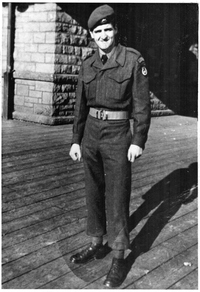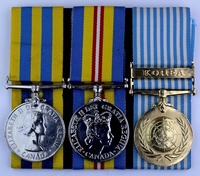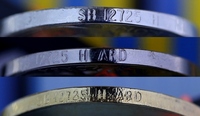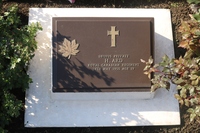
SB-12725 Private Henry "Hank" Ard
3rd Battalion, The Royal Canadian Regiment
By: Capt (ret'd) Michael M. O'Leary, CD, The RCR
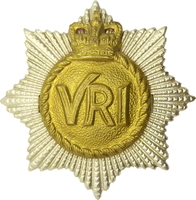
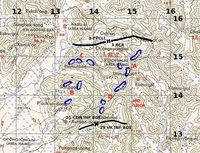
Majon-Ni 1951 Map Sheet L751-6528 II (cropped), with trace showing 3RCR battle positions at Hill 187. Map sourced from Korean War Project. Battle positions from Official History of the Canadian Army in Korea; Strange Battleground.
Henry "Hank" Ard was born in Niagara Falls, Ontario, on 16 Sep 1933. His parents were William Henry and Jessie Ballantyne (nee Mann) Ard. Henry was the third of seven children in the family.
Ard was medically examined for service in the Canadian Army on 21 Jan 1952. His PULHEMS score was "1's" across all seven assessment factors. The PULHEMS physical assessment measured the subject's Physique, Upper Extremity, Lower Extremity, Hearing And Ears, Eyes And Vision, Mental Capacity, and Emotional Stability. A score between "1" and "8" was assigned to each category, with "1" being considered excellent.
Ard was enrolled in the Canadian Army on 23 Jan 1952 and given the service number SB-12725. His Personnel Selection Record provided the following details:
"Educational Background: Completed Grade VIII.
"Occupational Background: 6 mos – Painter, houses, etc.; 1 1/2 years – spray painter, machinery, etc.
"Military Background: Nil.
"Additional Information:
"ARD originates in Niagara Falls, Ontario. He is third of a family of seven. His family are not closely attached for some of his brothers and sisters are spread over much of the continent, and their whereabouts are not known to each other. He says he got along well with his parents.
"He has disclosed an incident in Niagara Falls, N.Y. where he was responsible for breaking a store window in a fight. He says he had to make restitution, but was not punished further.
"He appears fairly intelligent with a fairly steady record as a painter. He wants to serve in Infantry.
"Recommendations: RCIC – General Duty – 3 Bn RCR.
On enlisting, Ard was taken on the strength of No. 6 Personnel Depot "from Civil Life." He drew the pay of a Private soldier on entry and was granted seven days leave with Ration Allowance of $20.00 per month.
Although Ard's Personnel Selection Form noted no prior military service, on one document in his records it is noted that he claimed prior service with The Lincoln and Welland Regiment. Ard's service number is in the format used during and after the Second World War. The "S" prefix indicated post-war usage. The number "B-12725" is from a number block assigned to Military District No. 2, denoted for soldiers recruited within the District for 40th Field Battery, RCA. It's use for Ard probably indicates that it was an available number block for Militia recruits after the war and used as needed for new enlistments. If Ard was assigned this number on enlistment with the Lincoln and Welland Regiment, it would explain why he did not receive a service number in the format used for Korean War enlistments, "B-800xxx."
On 13 Mar 1952, Henry Ard was struck off the strength of No. 6 Personnel Depot on transfer to the 3rd Battalion, The Royal Canadian Regiment (3RCR), at Camp Petawawa.
The 3rd Battalion was authorized to be formed on 9 Dec 1950 as an Active Force unit embodied in the Special Force for service in Korea. The regimental journal, The Connecting File (Summer 1951) notes the formation of the unit based on the Special Force's Reinforcement Group with the addition of its first new intakes on 10 Jan 1951. As the Battalion trained for its future operational role, it also continued to provide reinforcement drafts for the regimental units that had preceded it overseas.
While at Camp Wainwright with the 3rd Battalion, on 4 Jun 1952, Ard was qualified "Pte, 2nd Class." He completed his basic training on 13 Jun 1952. His course officer, 2Lt D.J. Bamford, entered the following note in his records: "An intelligent soldier but does not pull his weight in the platoon. Is inclined to be insubordinate. Passed TsOET (i.e., Tests of Elementary Training) on Rifles, LMG, SMG, and #36 Grenades.)" Ard qualified as a 2nd Class shot with the rifle and SMG.
Ard demonstrated his reluctance to fully meet the Army's service expectations when, on 21 Jul 1952, he was reported Absent Without Leave (AWL) from 0630 hrs. Ten days later, on 31 Jul 1952, Ard was arrested at the Victoria Hotel in Calgary, Alta., by a Detective of the City of Calgary Police Department. Handed over to military authorities at Currie Barracks on 5 Aug 1952, Ard's arrest report notes that he was dressed in civilian clothing at the time. Ard's arrest report also provides a physical description. He was 6-feet tall, with brown hair, blue eyes, and sallow complexion.
Charged on 1 Aug 1952 under Section 81 of the National Defence Act (NDA) for an absence of 9 days, 18 hours, and 30 minutes, Ard was found guilty. He was fined $10.00 and awarded 14 days of Confinement to Barracks (CB). Five days later, he had another $8.06 deducted from his pay account under the financial section of Queen's Regulations, article 208.4, which covered "Deductions for Transportation of Recovered Absentees or Deserters."
Ard's military justice experience after going AWL did not fully inspire him to apply self-discipline to his life in the army. On 4 Sep 1952 he was charged again, fined fine $15.00, and awarded another 14 days of CB. This time, his charge was under Section 75 of the NDA which covered offences where the accused has struck, attempted to strike, or offered violence against a superior officer.
When he was not getting in trouble, Ard was participating in the 3rd Battalion's training in preparation for their future role overseas. In July 1952, Ard attended "Mountain Training" at Jasper Park. He also took part in "Corps Training," a one-week exercise (Buffalo II). Ard completing his Advanced Training on 20 Sep 1952, a note in his records states "This soldier's conduct has not been good but considerable improvement shown during latter part of training."
Ard completed a Military Will form on 13 Nov 1952. In this document he identified his mother, Mrs. Jessie Ballantyne Ard, 859 Ontario Ave., Niagara Falls, Ont., as his sole heir to inherit his estate. Ard designated his father and his sister Dorothy (Tosetto) to be his executors.
Selected for an overseas draft, Ard was struck off the strength of 3RCR to No. 11 Personnel Depot (PD) on 18 Nov 1952. Located at Vancouver, B.C., No. 11 PD handled the despatch and receipt of personnel going overseas to or returning from Korea.
On 24 Nov 1952, Ard was struck off the strength of No. 11 PD and posted to the X-4 List (i.e., Unposted Reinforcements) of 2 Canadian Administration Unit (2 CAU). On embarking in Canada the following day, he was granted Foreign Allowance and posted to the Canadian Army (Far East) (CA (FE)). Ard disembarked in Japan on 8 Dec 1952.
Before his first week in Japan was complete, Ard was again in trouble with the Army. On 13 Dec 1952 he was the subject of a summary trial, charged with four offences. These charges were under (1) sec 74 NDA (disobeys a lawful command), (2) sec 78 NDA (being concerned in a quarrel, fray, or disorder, etc.), (3) sec 118 NDA (an act, etc., to the prejudice of good order and discipline) and (4) sec 81 NDA (AWL from 2230 to 2235 hrs 12 Dec 1952 (5 min)). Found guilty, Ard was awarded 14 days CB and fined $25.00.
On 8 Jan 1953, Ard was struck off the strength of the X-4 List under 2 CAU and posted to the 1st Battalion, The Royal Canadian Regiment (1RCR) in Korea. The battalion was nearing the end of its year-long tour in Korea and after a month of patrols and sniping, on 28 Jan 1953, 1RCR moved behind the front lines in preparation for relief and their return to Canada.
For Ard and other soldiers who had joined 1RCR throughout the Battalion's time overseas, many would be posted to the incoming 3rd Battalion to finish their own commitment for overseas duty. Accordingly, on 27 Mar 1953, Private Henry Ard was posted from 1RCR to 3 RCR. Four days later, on 31 Mar 1953, 3rd Battalion officially relieved the 1st Battalion in Korea. Initially placed in "A" Company, Ard was transferred to "D" Company and then to "C" Company in early April.
"C" Company's notes in the regimental journal, The Connecting File (Spring-Summer 1953) describe the 3rd Battalion's preparations:
"On 25 Mar, a ceremonial parade was held, and with a Guard of Honour from each of the Bns, 3 Bn officially took over operational responsibility from 1 Bn. Due to the large number of 1 Bn personnel to be absorbed, the next few days were spent in reorganization and training. The Coy top slate at this time included Capt Mullin as OC, 2/Lt Hollyer and Lt Loomis as Pl Comds, WO2 DeCoste as CSM, and S/Sgt Sullivan as CQMS.
"Coy, Bn and Bde exercises were carried out during the early part of April. Hill climbing became a daily chore. On 4 Apr 53, Lt R.D. Goodwin arrived from Canada and took over 9 Pl."
It was not long before the soldiers of the 3rd Battalion returned to (or were introduced to) the front lines. The unit relieved the Royal 22ieme Regiment ("Van Doos") on 19 April 1953 on the feature which would become known in regimental history as Hill 187.
The Canadian official history, Strange Battleground (Wood, 1966), provides a description of the terrain and tactical dispersion of the battalion in which the soldiers of the 3rd Battalion found themselves:
"The ground the battalion occupied was typical of that along the greater part of the "Jamestown" line. The area fronted on the Sami-ch'on; the highest ground, Hill 187, lay in the north-east comer. Three irregular fingers of high ground radiated out from this feature to the north-west, to the west and to the south-west. Hill 159 rose from the last-named of these ridges, and. three additional fingers ran west from it, roughly paralleling each other and the ridge which ran west from Hill 187. At least the northern two of these four ridges running west were open to observation from Hill 166, on the enemy's side of the valley.
"All these ridges and hills were steep-sided, and their slopes were seamed by gullies and folds of varying depths. These depressions made it difficult – and in most cases impossible – to cover the slopes running down from any given locality by direct small arms fire. Medium machine-guns from neighbouring localities might have covered these difficult areas, but none were sited for this role. At the same time, the steepness of the hillsides sharply limited the fields of fire of small arms unless the firer exposed himself to a dangerous extent above the lip of his fire bay. To further complicate the problem, the hillsides were covered with scrub and long grass which, even in winter, gave good cover from view to a crouching man. It was a familiar problem in defence; most of the "Jamestown" line suited current tactical doctrine but the R.C.R. position did not, although it had to be held in order to maintain the security of the rest. It would seem that for this position at any rate, some variant of the American practice of holding below the hill-tops would have been an improvement.
"The ground between the ridges and hills varied from narrow, bush choked ravines to wide, flat-bottomed valleys floored with paddy. Within the battalion area three roughly parallel valleys separated the four fingers of high ground which have already been mentioned. At night these valleys offered an approach to the heart of the battalion area, while the ravines and gullies that ran into the slopes from these valleys offered covered approaches up the sides of the fingers. In the valleys the earth was rich, deep and dark-coloured. Towards the summit of the ridges, it was mixed with a shale rock, which was easy to split but hard to dig. At this level, the soil was yellowish-red in colour, with a clay content which made it soggy when wet, but it had the advantage of holding up reasonably well at the edges of any digging not revetted. Even at the tops of the hills the soil was surprisingly deep. Trenches could be dug there to a depth of at least six feet without striking solid rock.
"The battalion area, in common with the others in the Commonwealth sector, was laid out in defended localities, according to the doctrine stated in Chapter VI of the British pamphlet, The Infantry Division in Battle, 1950. This doctrine had so commended itself to the Americans that Major-General. West mentions a special printing of the chapter for wide distribution in 1st U.S. Corps.1 The R.C.R. companies were laid out in the following pattern: "A" was on the high ground about Hill 187; "D" was on the ridge to the south-west; "C", with which this portion of the narrative is particularly concerned, held the western half of the ridge running west from Hill 187, while the platoons of "B" Company were distributed between the two ridges to the south. Within "C" Company, No, 7 Platoon was on the western tip of the finger, about Hill 97. No. 8 was two to three hundred yards in rear and No. 9 Platoon, with company headquarters, held Hill 123 approximately 400 yards to the east. A jeep road ran along thee northern side of the ridge which lay to the south of the Hill 97-123 ridge. This road turned north across the valley between the two ridges, and this stretch had a camouflaged canvas wall along its west side, to screen it from enemy observation.
"One of the significant features of this layout was dispersion. The distances separating even the platoons of "C" Company were not small, but the two platoons of "B" on the ridge immediately to the south of "C" Company were at least 700 yards away, and the nearest troops of the P.P.C.L.I. lay 1,000 yards to the north-east. At the same time, the forward platoon of "A" Company was approximately 800 yards behind the rear platoon of "C" on Hill 123. These distances precluded effective mutual support by rifle or light machine-gun fire, although support by medium machine-guns was possible."
The regimental history (Stevens, 1967) also notes the conditions of the battlefield in the opening paragraphs of a section titled "C Company's Ordeal":
"C Company, which held a finger of high ground running into the west from Hill 187, was deployed with 7 Platoon well forward at the tip of the finger, 8 Platoon in a reserve position at its knuckle and 9 Platoon about 400 yards away in the palm of the hand. This degree of dispersal was fairly general, for the Battalion was thin on the ground, with D Company 700 yards to the south and A Company on the crest of Hill 187 800 yards away; B Company to the south alone was in position to give effective supporting fire to the forward units. (Lest there be any tendency to attribute these dispositions to inexperience, the positions were exactly the same as those occupied by Second Battalion in the advance to the JAMESTOWN line in September 1951.)
"Colonel Campbell was not pleased with the conditions of his sector. The trenches were too shallow, the bunkers too flimsy, the fire bays too exposed, the wiring too light, for his taste. He set his men to work immediately on improvements but before appreciable progress had been made the enemy struck."
The Chinese welcomed the Royal Canadians with artillery fire. The battalion reported its first casualties on 22 Apr 1953. The "C" Company narrative in the regimental journal also describes the takeover of the position and the battlefield conditions met by 3RCR:
"The Officers and some NCOs made Recces of the forward Bn Areas, and 18 Apr 53 the Coy advance party went "into the line." They were welcomed by a more than usual volume of shells, and received their "baptism of fire." During the night of the 19 Apr 53, "C" Coy took over from their opposite number in 1 R22eR, and on the morning of the 20 Apr 53 the changeover was complete. "C" Coy had drawn the right forward Coy position, the "sharp end" as it became known. Indeed this fact was brought home sharply during the next two weeks. … The jeephead was in the reserve Coy position, and the Coy was on "C" rations. Life was not too pleasant with continual shelling all day long, and Chinese patrols nibbling at the wire all night.
"On 24 Apr 53, Ptes Rodgerson and Grennan were wounded by mortars and on the next day three more men were lost from wounds; Pte Roach, L/Cpl Pannachetti and a KATCOM Pte Kim Sung Kyoun. Snipers had a periodic "go" at the Coy, but inflicted no casualties.
"Daily shelling continued and on the 29 Apr 53, Pte Ard was wounded by a mortar bomb, and subsequently died. The patrols experienced no real contacts with the enemy during this period, but the Chinese presence was felt in many ways."
On 29 Apr 1953, Ard was wounded in action by artillery or mortar fire on the "C" Company position. The Battalion's War Diary, in stereotypical "All Quiet on the Western Front" style, makes no mention of the incident, stating "A day of normal work. Weather sunny and warm." The "C" Company War Dairy entry provides little more:
"Shelling continues, 1 casualty, SB 12725 Pte ARD H WIA. Our patrol was caught by flares which went out for two minutes which allowed them to get back."
Ard was wounded and evacuated only a few days before the Battalion's first and most serious clash with the enemy. "C" Company, in particular, would feel the weight of an enemy assault on 2/3 May 1953. The Company's narrative in the regimental journal described their experience during the fight for Hill 187, including a summary of the costs to "C" Company:
"C" Coy's first tour in the line had been costly. Our casualties were as follows: Killed in action and died of wounds, 18; Wounded in action, 17; Missing in action, 7; Wounded accidentally, 1.
"In addition "C" Coy KATCOMS were in the thick of things, with a total of 5 KIA, 4 MIA, 12 WIA."
Although there is no indication in the War Diary entries, Ard's wounds were severe and would lead to his death. Completed by the staff of the Director of Records, Ard's Battle Casualty Extract Form notes: "Wounded in Action, 29 Apr 1953, Korea, Multiple SFW and compound fracture of both legs, admitted 43 MASH and placed on the SI (seriously ill) List, 0920 hrs, 29 Apr 53."
Evacuated from the battalion's battle position, Ard was admitted to 60 Indian Field Ambulance on 29 Apr 1953 and the same day transferred to 43 MASH. Three days later, he was transferred again to, 121 Evac Hospital. On 8 May 1953, Ard was admitted to the British Commonwealth Hospital in Japan.
Despite the medical system's best efforts to stabilize Ard's condition and treat his extensive wounds, he died on 14 May 1953 at 0555 hrs. Later that morning he was subjected to a postmortem examination. The exam report details the damage to his body and the amputation of his left leg below the knee. The cause of death was recorded as "Multiple GSW of lower limbs and abdomen." (GSW is a general term used for "gun shot wound" which could be any injury caused by bullets, shrapnel, or shell splinters.)
On 16 May 1953, Private Henry Ard was buried in the British Cemetery at Yokohama, Japan. He rests in grave number D.B.7. Ard is one of five Royal Canadians buried at Yokohama.
Ard listed his mother as a his sole beneficiary in his will. On 20 May 1953, the Estates Section of NDHQ sent to Jessie Ard a form for her to complete. Her entries on the form showed that William and Jessie Ard were living at 859 Ontario Ave., Niagara Falls, Ont. She listed all of Henry Ard's siblings: Robert (29), Christopher (21), Walter (16), Dorothy (27), Mabel (23), and Gladys (14). All were shown living in the family home except Dorothy and Mabel, who also resided in Niagara Falls.
On 19 Jun 1953, a silver Memorial Cross was sent to Jessie Ard to memorialize her son's death.
For his service in the Korean War, Ard was entitled to receive the Canadian Korea Medal and UN Service Medal for Korea. These were despatched to his parents on 14 May 1953. In 1992, he was also posthumously awarded the Canadian Volunteer Service Medal for Korea on 26 Jun 1992.
Pro Patria
Visit a randomly selected page in The O'Leary Collection (or reload for another choice):
- The O'Leary Collection; Medals of The Royal Canadian Regiment.
- Researching Canadian Soldiers of the First World War
- Researching The Royal Canadian Regiment
- The RCR in the First World War
- Badges of The RCR
- The Senior Subaltern
- The Minute Book (blog)
- Rogue Papers
- Tactical Primers
- The Regimental Library
- Battle Honours
- Perpetuation of the CEF
- A Miscellany
- Quotes
- The Frontenac Times
- Site Map
QUICK LINKS
The O'Leary Collection—Medals of The Royal Canadian Regiment
Newest additions:
![]()
![]() SB-12725 Private Henry "Hank" Ard
SB-12725 Private Henry "Hank" Ard ![]()
WIA at Hill 187, Died of Wounds in Japan
![]()
![]() 2355331 Lance Corporal Albert Lorking
2355331 Lance Corporal Albert Lorking
Wounded in action, later a War Amps representative.
![]()
![]() 4334 / 477996 Pte Isaac Hamilton Wilcox
4334 / 477996 Pte Isaac Hamilton Wilcox
Permanent Force, South Africa, and C.E.F.
![]()
![]() 477019 Private Harold Ashcroft
477019 Private Harold Ashcroft
Transferred to the Tunnelers.
![]()
![]() 734231 Private Clark D. Thompson
734231 Private Clark D. Thompson ![]()
The older Thompson brother, killed in action.
![]()
![]() 733849 Private Norman Parker Thompson
733849 Private Norman Parker Thompson
The younger Thompson brother; post-war service in the Special Guard.
![]()
![]()
![]() A305 / 400305 Private Andrew Walker
A305 / 400305 Private Andrew Walker ![]()
"Previously reported Wounded, now Killed in Action."
![]()
![]() 823298 Pte Thomas Patrick Steele, M.M.
823298 Pte Thomas Patrick Steele, M.M. ![]()
… for gallant conduct in the field …
![]()
![]() P13066 Sergeant Harold Thompson
P13066 Sergeant Harold Thompson
Instrumental Soloist for over 20 years of Canadian Army service.
![]()
![]() 9609 / 477728 Private Albert Edward Piper
9609 / 477728 Private Albert Edward Piper
"Arrived from England as a STOWAWAY …"
